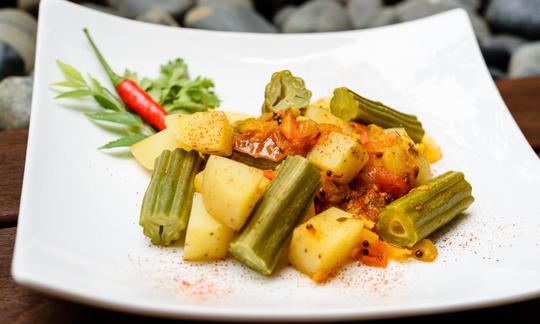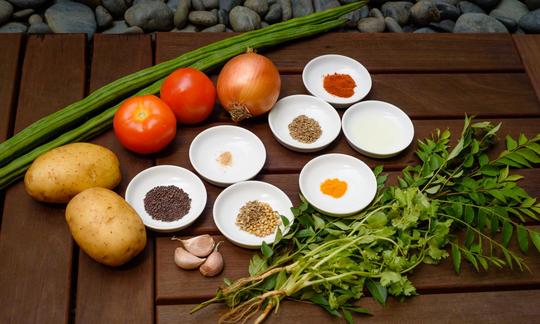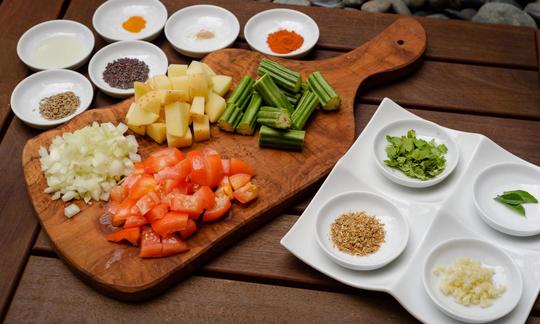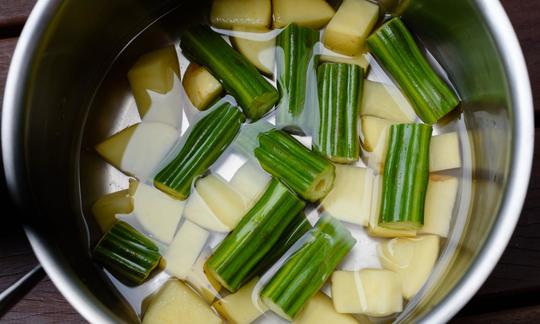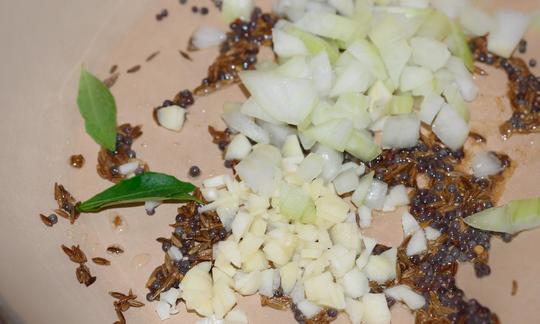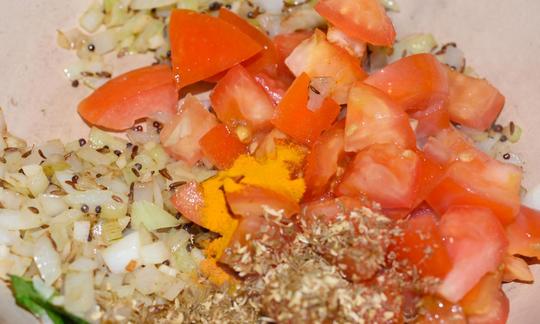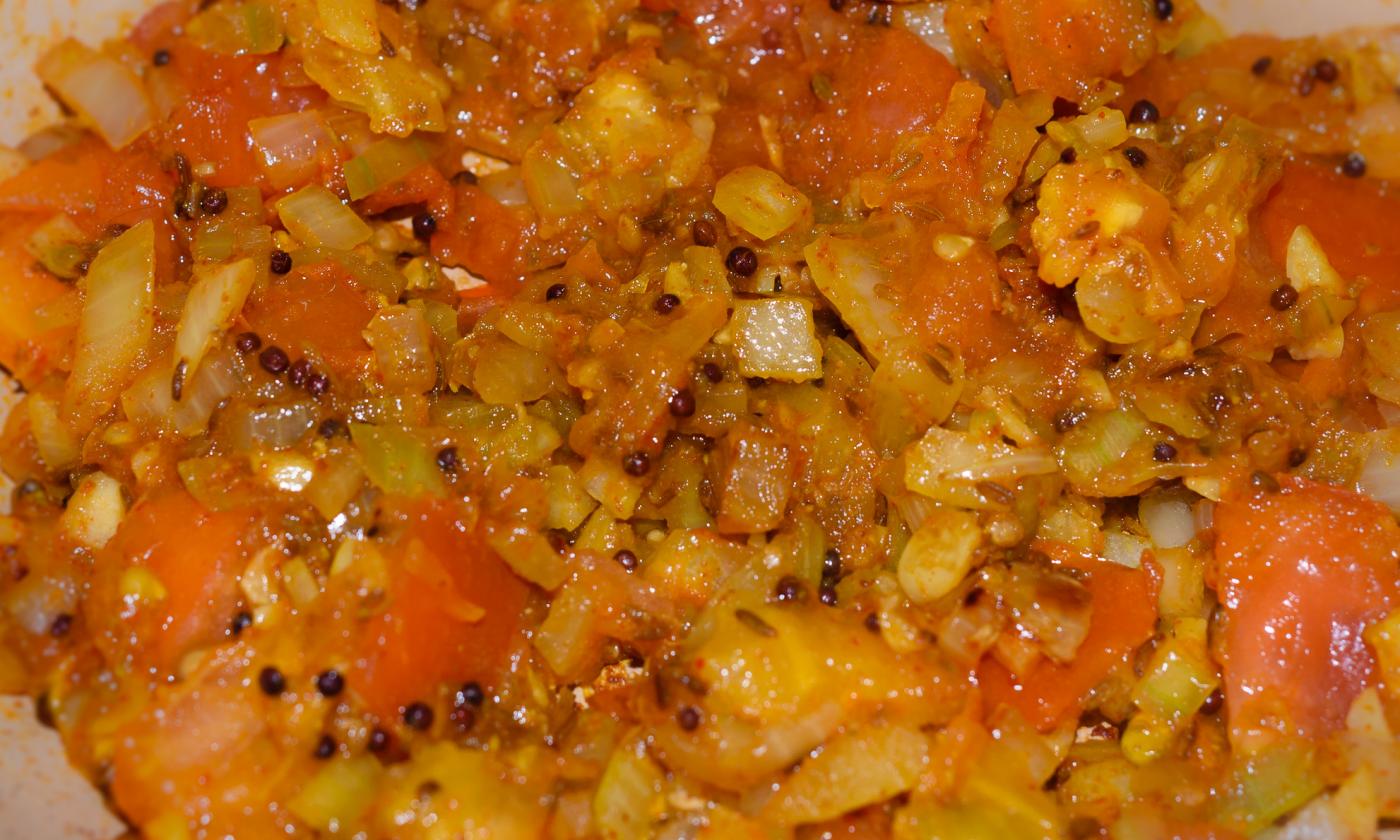Indian drumstick curry with potatoes and tomatoes
vegan
Ingredients (for servings, )
| For the drumstick curry | |
|---|---|
| 6 ½ oz | Horseradish tree pods (Moringa oleifera, organic?), raw |
| 8 ½ oz | Potatoes, raw (organic?) |
| 1 dash | Table salt (table salt, raw?, organic?) (0.01 oz) |
| 500 ml | Drinking water, raw (organic?) (18 oz) |
| 1 tsp | Rapeseed oil, refined (organic?) (0.16 oz) |
| 1 tsp | Mustard seeds, black, raw (organic?) (0.18 oz) |
| 1 tsp | Cumin, seeds (raw, organic?) (0.07 oz) |
| 5 ½ oz | Onions, raw (organic?) |
| 2 cloves | Garlic (organic?) (0.21 oz) |
| 5 | Curry leaves (raw?, organic?) (0.03 oz) |
| 11 oz | Tomatoes, raw (organic?) |
| ½ tbsp | Real coriander, seeds (raw?, organic?) (0.09 oz) |
| 2 tsp | Chili powder (raw?, organic?) (0.19 oz) |
| ¼ tsp | Turmeric (saffron root), ground, raw (organic?) (0.03 oz) |
| For garnishing | |
| ¼ bunch | Coriander leaves, raw (0.18 oz) |
Equipment
- mortar
- skillet (frying pan)
- stove
- saucepan
Type of preparation
- cook
- chop or grind
- season to taste
- sauté
- remove the skin
Preparation
Preparing the vegetables
Wash drumsticks and cut into 2-3 cm long pieces. Wash potatoes and cut into thumb-sized pieces.The amount of drumsticks indicated for 5 people corresponds to approximately 2 pods.
Pour water into a saucepan, add drumsticks, potatoes and a little salt, stir and cook over medium heat for about 10 minutes, stirring occasionally. When the potatoes are almost done, put the pan aside.
Keep the cooking water, which contains a certain amount of water-soluble nutrients, for later!
Heat oil in a pan. Add mustard seeds and cumin and fry over medium heat for about 30 seconds.
For the spice preparation
Peel the onions and garlic and chop finely. Add them to the pan with the curry leaves and fry for another 2 minutes.Wash and roughly chop the tomatoes, grind the coriander seeds in a mortar. Add them to the pan with the fried spices, chili powder and turmeric. Mix well and simmer for a further 3 minutes.
You can mash the tomatoes and onions a little with a potato masher.
Finishing the Drumstick Curry
Add the pre-cooked drumsticks and potatoes (including the remaining cooking water) and cook for a further 4 minutes, stirring occasionally.Season with salt to taste.
Garnish and Serve
Wash the coriander, chop roughly and sprinkle over the drumstick curry before serving.
|
Nutritional Information per person
Convert per 100g
|
2000 kcal | |
|---|---|---|
| Energy | 95 kcal | 4.7% |
| Fat/Lipids | 1.8 g | 2.6% |
| Saturated Fats | 0.18 g | 0.9% |
| Carbohydrates (inc.dietary fiber) | 18 g | 6.8% |
| Sugars | 3.5 g | 3.8% |
| Fiber | 4.2 g | 16.8% |
| Protein/Albumin | 3.3 g | 6.5% |
| Cooking Salt (Na:89.9 mg) | 228 mg | 9.5% |
| Essential micronutrients with the highest proportions | per person | 2000 kcal | |
|---|---|---|---|
| Vit | Vitamin C (ascorbic acid) | 71 mg | 89.0% |
| Elem | Potassium, K | 611 mg | 31.0% |
| Vit | Vitamin B6 (pyridoxine) | 0.31 mg | 22.0% |
| Min | Manganese, Mn | 0.39 mg | 20.0% |
| Vit | Vitamin B9, B11 (Folate, as the active form of folic acid) | 40 µg | 20.0% |
| Min | Copper, Cu | 0.17 mg | 17.0% |
| Vit | Vitamin K | 11 µg | 15.0% |
| Elem | Magnesium, Mg | 47 mg | 12.0% |
| Elem | Phosphorus, P | 87 mg | 12.0% |
| Min | Iron, Fe | 1.6 mg | 11.0% |
Detailed Nutritional Information per Person for this Recipe
The majority of the nutritional information comes from the USDA (US Department of Agriculture). This means that the information for natural products is often incomplete or only given within broader categories, whereas in most cases products made from these have more complete information displayed.
If we take flaxseed, for example, the important essential amino acid ALA (omega-3) is only included in an overarching category whereas for flaxseed oil ALA is listed specifically. In time, we will be able to change this, but it will require a lot of work. An “i” appears behind ingredients that have been adjusted and an explanation appears when you hover over this symbol.
For Erb Muesli, the original calculations resulted in 48 % of the daily requirement of ALA — but with the correction, we see that the muesli actually covers >100 % of the necessary recommendation for the omega-3 fatty acid ALA. Our goal is to eventually be able to compare the nutritional value of our recipes with those that are used in conventional western lifestyles.
| Essential fatty acids | per person | 2000 kcal |
|---|---|---|
| Alpha-Linolenic acid; ALA; 18:3 omega-3 | 0.14 g | 7.0% |
| Linoleic acid; LA; 18:2 omega-6 | 0.38 g | 4.0% |
| Essential amino acids | per person | 2000 kcal |
|---|---|---|
| Tryptophan (Trp, W) | 0.02 g | 9.0% |
| Threonine (Thr, T, irreversibly transaminated) | 0.07 g | 8.0% |
| Lysine (Lys, K, irreversibly transaminated) | 0.10 g | 6.0% |
| Valin (Val, V) | 0.09 g | 6.0% |
| Isoleucine (Ile, I) | 0.07 g | 5.0% |
| Phenylalanine (Phe, F) | 0.08 g | 5.0% |
| Leucine (Leu, L) | 0.10 g | 4.0% |
| Methionine (Met, M) | 0.03 g | 3.0% |
| Vitamins | per person | 2000 kcal |
|---|---|---|
| Vitamin C (ascorbic acid) | 71 mg | 89.0% |
| Vitamin B6 (pyridoxine) | 0.31 mg | 22.0% |
| Vitamin B9, B11 (Folate, as the active form of folic acid) | 40 µg | 20.0% |
| Vitamin K | 11 µg | 15.0% |
| Vitamin B1 (Thiamine) | 0.11 mg | 10.0% |
| Vitamin B3 (Niacin) | 1.4 mg | 9.0% |
| Vitamin B5 (Pantothenic acid) | 0.55 mg | 9.0% |
| Vitamin E, as a-TEs | 1.1 mg | 9.0% |
| Vitamin B7 (Biotin, ex vitamin H) | 3.8 µg | 8.0% |
| Vitamin B2 (Riboflavin) | 0.08 mg | 6.0% |
| Vitamin A, as RAE | 50 µg | 6.0% |
| Essential macroelements (macronutrients) | per person | 2000 kcal |
|---|---|---|
| Potassium, K | 611 mg | 31.0% |
| Magnesium, Mg | 47 mg | 12.0% |
| Phosphorus, P | 87 mg | 12.0% |
| Sodium, Na | 90 mg | 11.0% |
| Calcium, Ca | 52 mg | 6.0% |
| Essential trace elements (micronutrients) | per person | 2000 kcal |
|---|---|---|
| Manganese, Mn | 0.39 mg | 20.0% |
| Copper, Cu | 0.17 mg | 17.0% |
| Iron, Fe | 1.6 mg | 11.0% |
| Zinc, Zn | 0.64 mg | 6.0% |
| Selenium, Se | 2.2 µg | 4.0% |
| Fluorine, F | 74 µg | 2.0% |
| Iod, I (Jod, J) | 2.9 µg | 2.0% |
The Indian drumstick curry with potatoes & tomatoes owes its aroma to the many spices such as coriander, mustard seeds, turmeric etc.
Drumsticks: Drumsticks are the bean-like pods of the horseradish tree, also known as the miracle tree or Moringa Oleifera. Still largely unknown in Europe, the Moringa plant has been part of the Indian diet for thousands of years. The Moringa tree is characterized by its short, swollen trunk and its 40 cm long, hanging bean fruits that look like drumsticks. The German name horseradish tree is derived from the mustard oil glycoside content, which causes the roots of the Moringa tree to smell pungently and burning like horseradish. The edible parts of the plant, especially the leaves and fruits, have a high nutritional value and are rich in antioxidants, proteins, minerals and vitamins. When cooked, drumsticks have a taste similar to asparagus. Unlike asparagus, however, the green pods are not so suitable as a stand-alone vegetable, but are better as a light and healthy side dish. In South India, the moringa pod is said to have certain medicinal properties. Drumstick soup is said to help with coughs and sore throats and has a blood-cleansing effect.
Cumin: Due to the similar name, there is often confusion between cumin and caraway. They are not closely related and also differ greatly in taste. Cumin is often used in Indian, Turkish and Greek cuisine.
Turmeric: Turmeric, also known as yellow ginger or turmeric root, comes from South Asia and belongs to the ginger family. Fresh turmeric has a resinous, slightly burning taste; dried, as is often used in India, it tastes milder and slightly bitter. Turmeric is best stored in a dark place and not for too long, as otherwise the color and aroma will be lost.
Coriander seeds: Coriander seeds are spherical and have a bitter-spicy to sweet aroma. The ground seeds are used in the kitchen as spices. The coriander seeds taste particularly spicy if you roast them briefly and then grind them or crush them in a mortar.
Curry leaves: The leaves of the curry tree, which is native to Asia, are called curry leaves. Curry leaves are used as a spice in many vegetarian dishes, especially in Sri Lankan and South Indian cuisine. The aroma of curry leaves is fresh, slightly fruity to smoky. The thin leaves do not need to be removed from the dish; they can be eaten. They are usually fried in hot oil or ghee before adding the other ingredients. In Ayurveda, the traditional Indian natural medicine, curry leaves are used to treat stomach upsets and digestive disorders, eczema and diabetes. Experiments have shown a drop in blood sugar levels.
Black mustard: The ripe and dried, intensely fragrant seeds are used primarily in Indian cuisine. They are usually roasted in ghee or oil beforehand. The mustard seeds give the dish a slight spiciness, which is, however, very different from the taste of creamy mustard. Like all cruciferous seeds, mustard seeds contain oil, which in black mustard is around 30%, with a high proportion of unsaturated fatty acids. Mustard seeds have a stimulating effect on digestion.
How to eat drumsticks properly: The pods have a woody shell that does not soften sufficiently even during the cooking process. The only edible part is the almost jelly-like inside of the pod. To do this, cut the pod pieces lengthways and scrape out the soft inside with a fork.
Coriander leaves: Some people react to the intense, slightly soapy aroma of coriander with aversion or even nausea. According to statistics in Switzerland, 15% of all allergy sufferers are sensitive to coriander. In these cases, simply leave out this ingredient.
Mortar: The mortar, which is often used in oriental and Asian cuisine, can be used to grind ingredients to the desired consistency. A higher degree of grinding ensures a larger total surface area of the ground material, which intensifies the flavor. If you don't have a mortar, you can also use a pepper mill. Another alternative is ready-made coriander seed powder, which, however, tastes less intense than freshly ground seeds.
Cold-pressed rapeseed oil is not suitable in this case, as cold-pressed oils can only be heated slightly, in the case of cold-pressed rapeseed oil up to a maximum of 120 °C, as otherwise harmful substances are created. See the following link ( cold-pressed rapeseed oil ). But refined rapeseed oil should also be heated up to a maximum of 180 °C. Under no circumstances should it start to smoke, although decomposition will begin before that.
Goes well with: You can also add chopped carrots or peas to the dish.
Asafoetida (spice): In classic Indian dishes, the strong-smelling spice Asafoetida, also known as stinking asatan or devil's dung, is used for such a dish. It is the powder of a plant species from the family of the Umbelliferae. Asafoetida has a high resin content, which is partly responsible for the bitter, acrid taste and the very unpleasant smell, which, however, changes when used to a smell similar to that of onions and garlic .

